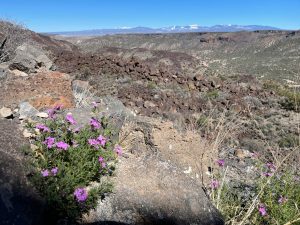
BY
CAJA DEL RIO – A vast plateau on Santa Fe’s doorstep, this area represents a widely diverse landscape teeming with cultural landmarks and lush with recreational opportunities.
Covering more than 104,000 acres, the area is rife with history, said Garrett VeneKlasen, New Mexico Wild northern conservation director. VeneKlasen has made many excursions into the vast territory, exploring it from it many access points.
A top recommendation, he said, is visiting the La Cieneguilla Petroglyphs – a collection of rock art encompassing both Native Americans dating more than 700 years ago, as well as Spanish Colonialists going back some 400 years.

“It kind of frames the place,” he said of the easy trek up the basalt rincon to view the hundreds of intricate etchings. “It puts it all in cultural context. That really is what the Caja del Rio is all about, that remarkable cultural history.”
A way to gauge the scale of the area while gaining a view of the Rio Grande, the Red Dot and Blue Dot trails outside of White Rock provide just the ticket, he said.
“If you want to have a sense of its enormity, a great place to go is the Red Dot Trail out of White Rock,” VeneKlasen said. “You stand on the west side of the Rio Grande canyon – White Rock Canyon – looking east onto the plateau. It’s a stunning place to visit.”
Combined with the Blue Dot Trail and the White Rock Canyon Rim Trail, it creates a 6.7-mile loop with an elevation change of 1,279 feet. It drops to the Rio Grande and includes a long stretch along the river bottom.
That portion of the Rio Grande “is a critical migratory corridor,” he said. “Eagles and other raptors and waterfowl and songbirds all use it. There was even a willow flycatcher spotted in there, so endangered species are in there. That river corridor is wild and beautiful, and very much untamed. The whole west side is rich with wildlife.”
On the plateau itself, the original La Bajada routes that local residents painstakingly carved into switchbacks up the hill in two different spots, marking New Mexico State Road 1 and later U.S. Route 66, can still be seen and remain a marvel that vehicles of the era were able to negotiate the incline.
Chacoan roads crisscross the plateau, connecting the pueblos of Jemez, Tesuque, Santo Domingo and Cochiti. And later the Spanish Camino Real de Tierra Adentro from Mexico City cut through the landscape to its terminus near Santa Fe after nearly 1,600 miles.

“The whole place is an artifact. We want to maintain that cultural integrity,” VeneKlasen said. “It’s New Mexican and American history; a history book on the land. It’s the best one in the Southwest and I would argue in all of the Americas because of all of these crossroads coming together.”
While the Caja del Rio is devoid of amenities, dispersed camping sites are abound.
The area has become popular with off-road vehicle riders and while there are plenty of rutted, backcountry roads to explore, too often new lanes are cut through the fragile ground, which can be a problem, VeneKlasen said.
With the site overseen by the Bureau of Land Management and U.S. Forest Service, there are definite issues with enforcement, resource protection, land management and, VeneKlasen said, so efforts to bring the entire area under one managing roof are gaining ground.
“The place personifies New Mexico,” he said. “When you look at the diversity of the community, there’s nothing like it in the Americas. But it’s death by a 1,000 cuts. There are so many cultural resources. Petroglyphs, power points, sacred sites, dry farming. It’s littered with cultural sites. One of our biggest sites, but we’re impacting the integrity of those special and sacred places.”

